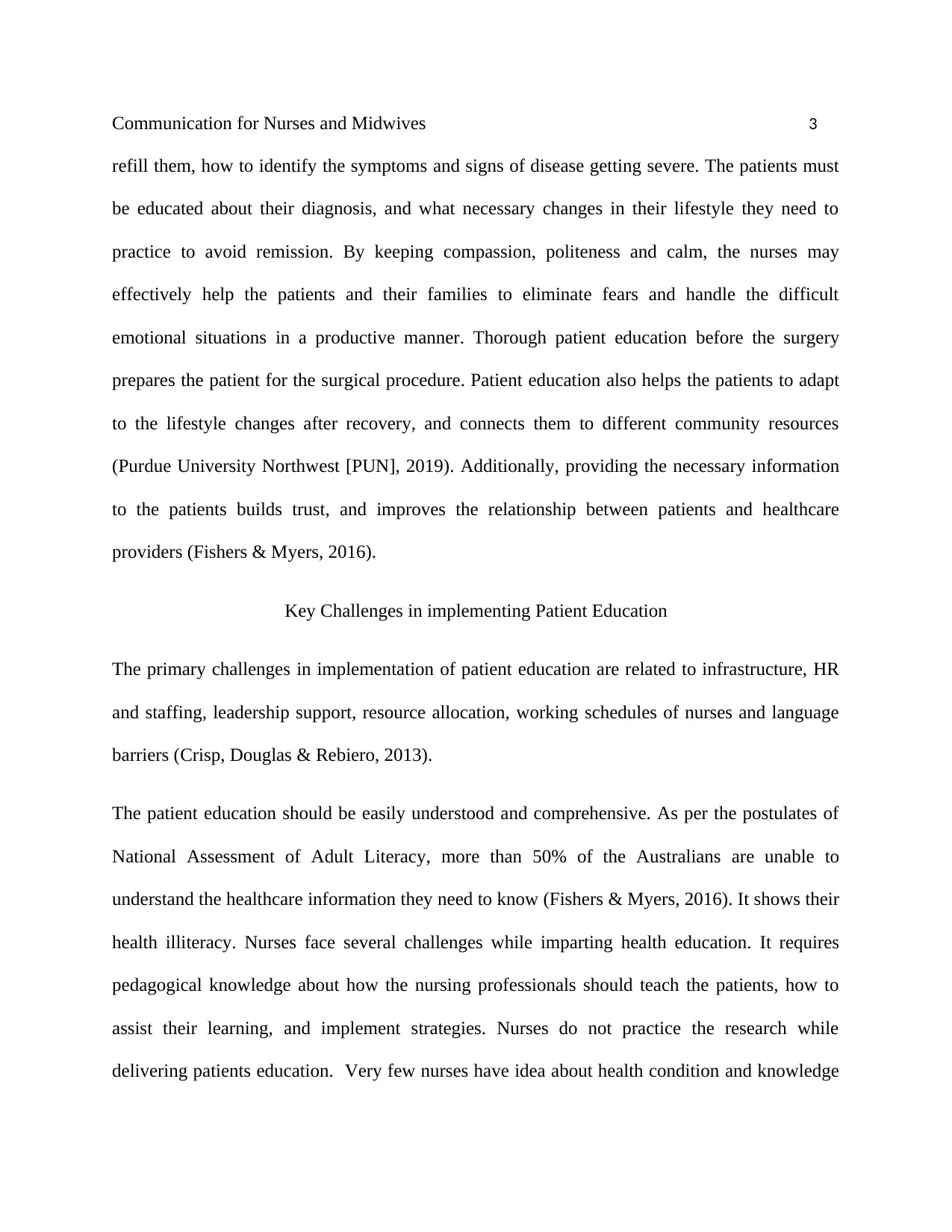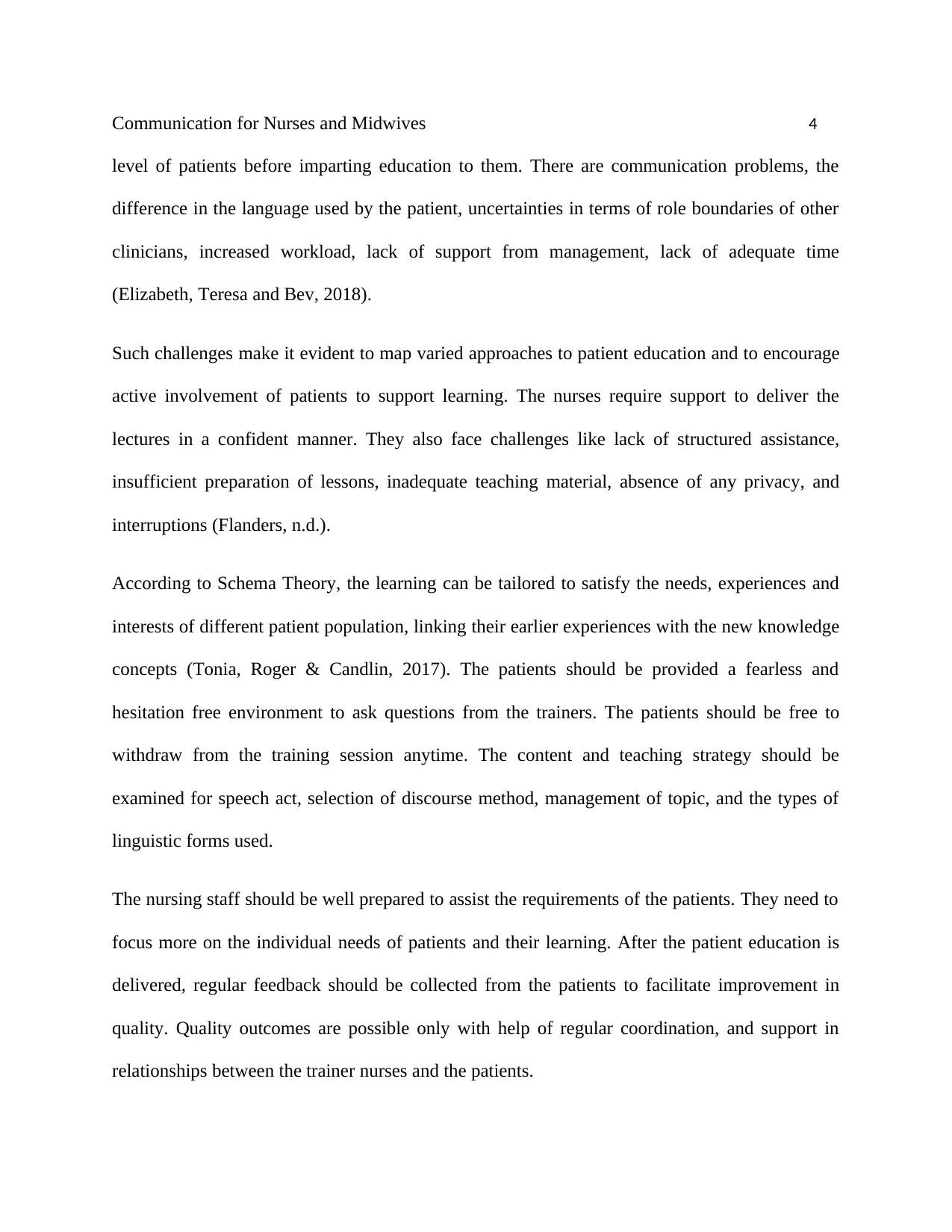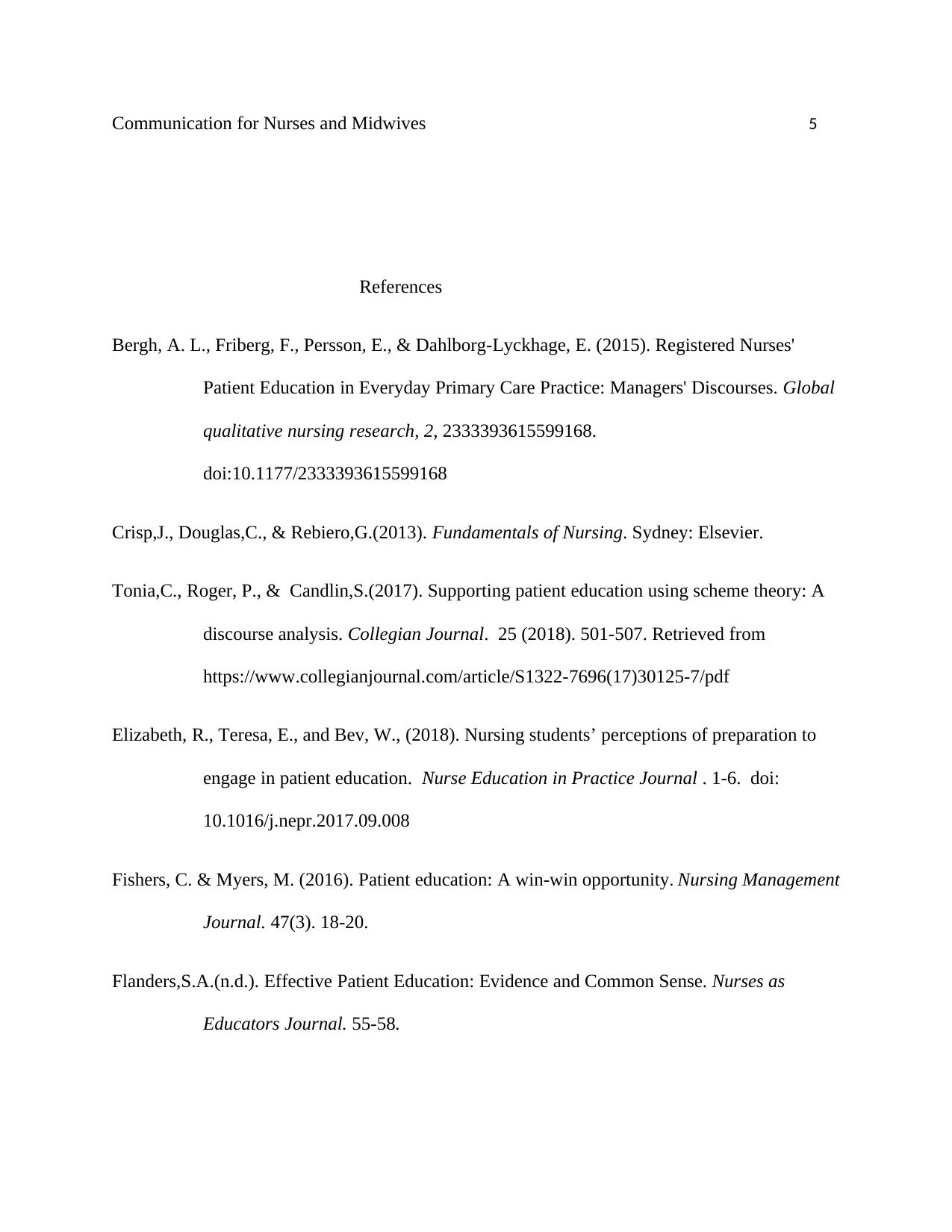NUM1102 Assignment: Importance of Patient Education in Nursing
VerifiedAdded on 2023/04/24
|6
|1211
|230
Essay
AI Summary
This essay explores the critical role of patient education in nursing and midwifery, emphasizing its importance in enhancing patient outcomes and improving healthcare delivery. It defines patient education as a process that equips patients with the knowledge and skills to manage their health effectively, fostering self-management and informed decision-making. The essay highlights the nurse's role in providing this education, discussing topics such as illness, medications, and lifestyle changes, and underscores the need for clear communication and empathy. It also addresses key challenges in implementing patient education, including infrastructure, staffing, and language barriers, while advocating for tailored approaches and active patient involvement. The essay concludes by emphasizing the importance of regular feedback and coordination between nurses and patients to ensure quality outcomes.

Running Head: Communication for Nurses and Midwives
Assignment
NUM1102: Communication for Nurses and Midwives
Patient /Client Education Essay
Student Name:…..
Submitted to:……
University:……
Assignment
NUM1102: Communication for Nurses and Midwives
Patient /Client Education Essay
Student Name:…..
Submitted to:……
University:……
Paraphrase This Document
Need a fresh take? Get an instant paraphrase of this document with our AI Paraphraser

Communication for Nurses and Midwives 2
Importance of Patient Education in Nursing
The patient education may be defined as a process of providing the patients with formal or
informal education to strengthen their role in decision making, to help them attain the attitude,
knowledge, behaviors and skills to successfully manage their health issues (Tonia, Roger &
Candlin, 2017). The main goal of patient education is to enhance the health status of individuals
and improve the performance of healthcare sector overall. It makes sure that the patients are well
educated and informed regarding their own health status. It improves the level of patient
understanding. Educated patients are further motivated to achieve their healthcare goals
efficiently.
The patients’ education is necessary to develop their knowledge, and facilitate readiness for self
management (Bergh, Friberg, Persson, & Lyckhage, 2015). The nurses hold a highly responsible
role in helping the patients manage their own health status and educate them. The healthcare
education provided by the nurses during hospitalization makes the patients capable of self care
and minimizes their re-hospitalization for the same problem. Discussion about the illness of
patients, medications, their use and side effects and follow up needs to be effectively done during
the discharge planning. It helps them to control and manage the acute and chronic diseases in a
better way. Patient education includes discussing about the potential alternate treatments, helping
them choose the best possible option for treatment, and implementing the ways to prevent further
health decline.
The patient education improves the patient outcome and reduces the expenses of medical care
(Nurse Journal, 2019). The patients should be told how to take their medicines, when and how to
Importance of Patient Education in Nursing
The patient education may be defined as a process of providing the patients with formal or
informal education to strengthen their role in decision making, to help them attain the attitude,
knowledge, behaviors and skills to successfully manage their health issues (Tonia, Roger &
Candlin, 2017). The main goal of patient education is to enhance the health status of individuals
and improve the performance of healthcare sector overall. It makes sure that the patients are well
educated and informed regarding their own health status. It improves the level of patient
understanding. Educated patients are further motivated to achieve their healthcare goals
efficiently.
The patients’ education is necessary to develop their knowledge, and facilitate readiness for self
management (Bergh, Friberg, Persson, & Lyckhage, 2015). The nurses hold a highly responsible
role in helping the patients manage their own health status and educate them. The healthcare
education provided by the nurses during hospitalization makes the patients capable of self care
and minimizes their re-hospitalization for the same problem. Discussion about the illness of
patients, medications, their use and side effects and follow up needs to be effectively done during
the discharge planning. It helps them to control and manage the acute and chronic diseases in a
better way. Patient education includes discussing about the potential alternate treatments, helping
them choose the best possible option for treatment, and implementing the ways to prevent further
health decline.
The patient education improves the patient outcome and reduces the expenses of medical care
(Nurse Journal, 2019). The patients should be told how to take their medicines, when and how to

Communication for Nurses and Midwives 3
refill them, how to identify the symptoms and signs of disease getting severe. The patients must
be educated about their diagnosis, and what necessary changes in their lifestyle they need to
practice to avoid remission. By keeping compassion, politeness and calm, the nurses may
effectively help the patients and their families to eliminate fears and handle the difficult
emotional situations in a productive manner. Thorough patient education before the surgery
prepares the patient for the surgical procedure. Patient education also helps the patients to adapt
to the lifestyle changes after recovery, and connects them to different community resources
(Purdue University Northwest [PUN], 2019). Additionally, providing the necessary information
to the patients builds trust, and improves the relationship between patients and healthcare
providers (Fishers & Myers, 2016).
Key Challenges in implementing Patient Education
The primary challenges in implementation of patient education are related to infrastructure, HR
and staffing, leadership support, resource allocation, working schedules of nurses and language
barriers (Crisp, Douglas & Rebiero, 2013).
The patient education should be easily understood and comprehensive. As per the postulates of
National Assessment of Adult Literacy, more than 50% of the Australians are unable to
understand the healthcare information they need to know (Fishers & Myers, 2016). It shows their
health illiteracy. Nurses face several challenges while imparting health education. It requires
pedagogical knowledge about how the nursing professionals should teach the patients, how to
assist their learning, and implement strategies. Nurses do not practice the research while
delivering patients education. Very few nurses have idea about health condition and knowledge
refill them, how to identify the symptoms and signs of disease getting severe. The patients must
be educated about their diagnosis, and what necessary changes in their lifestyle they need to
practice to avoid remission. By keeping compassion, politeness and calm, the nurses may
effectively help the patients and their families to eliminate fears and handle the difficult
emotional situations in a productive manner. Thorough patient education before the surgery
prepares the patient for the surgical procedure. Patient education also helps the patients to adapt
to the lifestyle changes after recovery, and connects them to different community resources
(Purdue University Northwest [PUN], 2019). Additionally, providing the necessary information
to the patients builds trust, and improves the relationship between patients and healthcare
providers (Fishers & Myers, 2016).
Key Challenges in implementing Patient Education
The primary challenges in implementation of patient education are related to infrastructure, HR
and staffing, leadership support, resource allocation, working schedules of nurses and language
barriers (Crisp, Douglas & Rebiero, 2013).
The patient education should be easily understood and comprehensive. As per the postulates of
National Assessment of Adult Literacy, more than 50% of the Australians are unable to
understand the healthcare information they need to know (Fishers & Myers, 2016). It shows their
health illiteracy. Nurses face several challenges while imparting health education. It requires
pedagogical knowledge about how the nursing professionals should teach the patients, how to
assist their learning, and implement strategies. Nurses do not practice the research while
delivering patients education. Very few nurses have idea about health condition and knowledge
⊘ This is a preview!⊘
Do you want full access?
Subscribe today to unlock all pages.

Trusted by 1+ million students worldwide

Communication for Nurses and Midwives 4
level of patients before imparting education to them. There are communication problems, the
difference in the language used by the patient, uncertainties in terms of role boundaries of other
clinicians, increased workload, lack of support from management, lack of adequate time
(Elizabeth, Teresa and Bev, 2018).
Such challenges make it evident to map varied approaches to patient education and to encourage
active involvement of patients to support learning. The nurses require support to deliver the
lectures in a confident manner. They also face challenges like lack of structured assistance,
insufficient preparation of lessons, inadequate teaching material, absence of any privacy, and
interruptions (Flanders, n.d.).
According to Schema Theory, the learning can be tailored to satisfy the needs, experiences and
interests of different patient population, linking their earlier experiences with the new knowledge
concepts (Tonia, Roger & Candlin, 2017). The patients should be provided a fearless and
hesitation free environment to ask questions from the trainers. The patients should be free to
withdraw from the training session anytime. The content and teaching strategy should be
examined for speech act, selection of discourse method, management of topic, and the types of
linguistic forms used.
The nursing staff should be well prepared to assist the requirements of the patients. They need to
focus more on the individual needs of patients and their learning. After the patient education is
delivered, regular feedback should be collected from the patients to facilitate improvement in
quality. Quality outcomes are possible only with help of regular coordination, and support in
relationships between the trainer nurses and the patients.
level of patients before imparting education to them. There are communication problems, the
difference in the language used by the patient, uncertainties in terms of role boundaries of other
clinicians, increased workload, lack of support from management, lack of adequate time
(Elizabeth, Teresa and Bev, 2018).
Such challenges make it evident to map varied approaches to patient education and to encourage
active involvement of patients to support learning. The nurses require support to deliver the
lectures in a confident manner. They also face challenges like lack of structured assistance,
insufficient preparation of lessons, inadequate teaching material, absence of any privacy, and
interruptions (Flanders, n.d.).
According to Schema Theory, the learning can be tailored to satisfy the needs, experiences and
interests of different patient population, linking their earlier experiences with the new knowledge
concepts (Tonia, Roger & Candlin, 2017). The patients should be provided a fearless and
hesitation free environment to ask questions from the trainers. The patients should be free to
withdraw from the training session anytime. The content and teaching strategy should be
examined for speech act, selection of discourse method, management of topic, and the types of
linguistic forms used.
The nursing staff should be well prepared to assist the requirements of the patients. They need to
focus more on the individual needs of patients and their learning. After the patient education is
delivered, regular feedback should be collected from the patients to facilitate improvement in
quality. Quality outcomes are possible only with help of regular coordination, and support in
relationships between the trainer nurses and the patients.
Paraphrase This Document
Need a fresh take? Get an instant paraphrase of this document with our AI Paraphraser

Communication for Nurses and Midwives 5
References
Bergh, A. L., Friberg, F., Persson, E., & Dahlborg-Lyckhage, E. (2015). Registered Nurses'
Patient Education in Everyday Primary Care Practice: Managers' Discourses. Global
qualitative nursing research, 2, 2333393615599168.
doi:10.1177/2333393615599168
Crisp,J., Douglas,C., & Rebiero,G.(2013). Fundamentals of Nursing. Sydney: Elsevier.
Tonia,C., Roger, P., & Candlin,S.(2017). Supporting patient education using scheme theory: A
discourse analysis. Collegian Journal. 25 (2018). 501-507. Retrieved from
https://www.collegianjournal.com/article/S1322-7696(17)30125-7/pdf
Elizabeth, R., Teresa, E., and Bev, W., (2018). Nursing students’ perceptions of preparation to
engage in patient education. Nurse Education in Practice Journal . 1-6. doi:
10.1016/j.nepr.2017.09.008
Fishers, C. & Myers, M. (2016). Patient education: A win-win opportunity. Nursing Management
Journal. 47(3). 18-20.
Flanders,S.A.(n.d.). Effective Patient Education: Evidence and Common Sense. Nurses as
Educators Journal. 55-58.
References
Bergh, A. L., Friberg, F., Persson, E., & Dahlborg-Lyckhage, E. (2015). Registered Nurses'
Patient Education in Everyday Primary Care Practice: Managers' Discourses. Global
qualitative nursing research, 2, 2333393615599168.
doi:10.1177/2333393615599168
Crisp,J., Douglas,C., & Rebiero,G.(2013). Fundamentals of Nursing. Sydney: Elsevier.
Tonia,C., Roger, P., & Candlin,S.(2017). Supporting patient education using scheme theory: A
discourse analysis. Collegian Journal. 25 (2018). 501-507. Retrieved from
https://www.collegianjournal.com/article/S1322-7696(17)30125-7/pdf
Elizabeth, R., Teresa, E., and Bev, W., (2018). Nursing students’ perceptions of preparation to
engage in patient education. Nurse Education in Practice Journal . 1-6. doi:
10.1016/j.nepr.2017.09.008
Fishers, C. & Myers, M. (2016). Patient education: A win-win opportunity. Nursing Management
Journal. 47(3). 18-20.
Flanders,S.A.(n.d.). Effective Patient Education: Evidence and Common Sense. Nurses as
Educators Journal. 55-58.

Communication for Nurses and Midwives 6
Nurse Journal (2019). Tips to improve patient education. Retrieved from
https://nursejournal.org/community/tips-to-improve-patient-education/
Purdue University Northwest (2017). The role of nurse in patient education. Retrieved from
https://nursingonline.pnw.edu/articles/nurses-in-patient-education.aspx
Nurse Journal (2019). Tips to improve patient education. Retrieved from
https://nursejournal.org/community/tips-to-improve-patient-education/
Purdue University Northwest (2017). The role of nurse in patient education. Retrieved from
https://nursingonline.pnw.edu/articles/nurses-in-patient-education.aspx
⊘ This is a preview!⊘
Do you want full access?
Subscribe today to unlock all pages.

Trusted by 1+ million students worldwide
1 out of 6
Related Documents
Your All-in-One AI-Powered Toolkit for Academic Success.
+13062052269
info@desklib.com
Available 24*7 on WhatsApp / Email
![[object Object]](/_next/static/media/star-bottom.7253800d.svg)
Unlock your academic potential
Copyright © 2020–2025 A2Z Services. All Rights Reserved. Developed and managed by ZUCOL.





